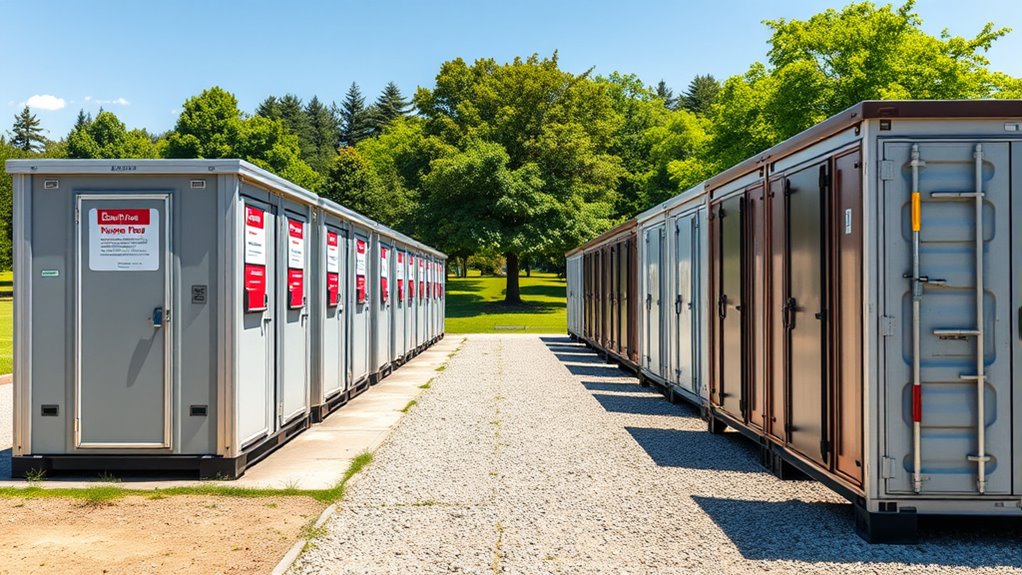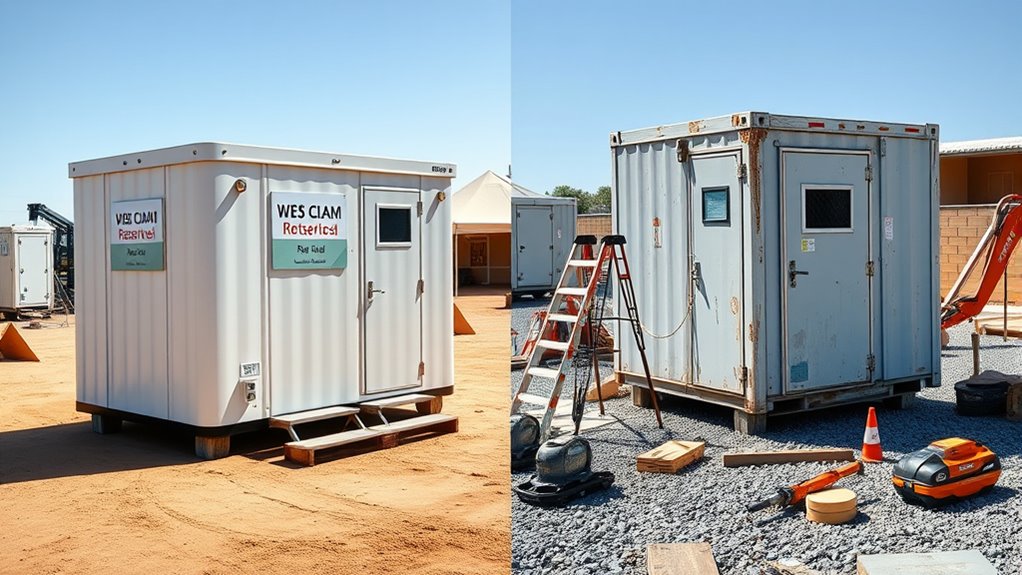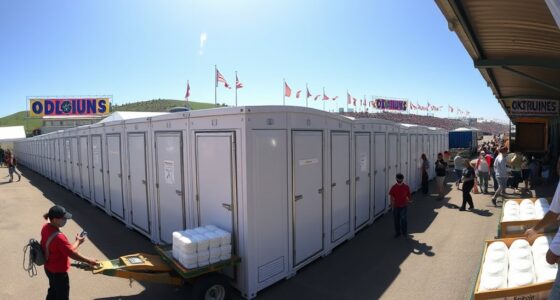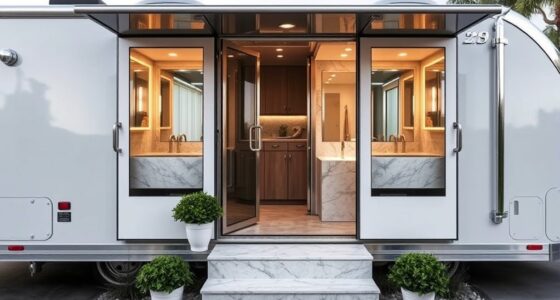Over ten years, renting portable restrooms works best for sporadic or short-term needs, as rental fees add up over time. Buying is more cost-effective if you plan frequent or ongoing use, since your initial investment pays off in lower long-term costs. Keep in mind, owning units also means handling maintenance and repairs. If you’re weighing the options, exploring the detailed breakdown can help you decide which approach fits your needs better.
Key Takeaways
- Renting is more cost-effective for short-term or infrequent use, while purchasing benefits high-volume, long-term needs.
- Initial purchase costs are higher, but owning units eliminates recurring rental fees and may include resale value.
- Rental agreements typically cover maintenance and cleaning, reducing owner responsibilities and ongoing costs.
- Owning requires internal or outsourced maintenance, which can increase expenses over time if not properly managed.
- A 10-year comparison should factor in purchase price, rental fees, maintenance, resale value, and usage frequency for optimal decision-making.

When deciding between renting or purchasing portable restrooms, understanding your specific needs and the long-term costs is essential. A thorough cost comparison can help you determine which option makes the most sense for your project or event. If you plan to use portable restrooms for a short-term event, renting often proves more economical and hassle-free. Rental companies typically include maintenance responsibilities, such as cleaning and restocking supplies, so you won’t have to worry about upkeep. This can save you both time and money, especially if you lack the resources or staff to handle regular cleaning and repairs.
On the other hand, purchasing portable restrooms might seem appealing if you anticipate frequent or ongoing needs over several years. While the upfront costs are higher, owning units means you eliminate recurring rental fees, which can add up over time. When doing a long-term cost comparison, you should consider the initial investment against the cumulative rental expenses. Purchasing also shifts maintenance responsibilities onto you, requiring you to establish a schedule for cleaning, repairs, and restocking. If you choose this route, you’ll need to decide whether to handle maintenance yourself or hire a service provider, which impacts your ongoing costs.
It’s important to factor in maintenance responsibilities carefully. Rental companies usually include maintenance in their rental agreements, covering routine cleaning, waste removal, and minor repairs. This convenience means you don’t have to allocate internal resources or worry about service schedules. Conversely, owning portable restrooms means you’re responsible for these tasks, which can incur additional costs and time commitments. If maintenance isn’t managed properly, units can become unsanitary or break down, leading to extra expenses and potential project delays. Additionally, understanding gaslighting behaviors can be helpful in navigating complex interactions related to maintenance or service disputes, ensuring clear communication and expectations.
Over a 10-year span, the choice between renting and purchasing hinges on usage frequency, available resources, and your budget. If your usage is sporadic or short-term, renting provides flexibility and reduces long-term financial commitment. However, if your needs are consistent and high-volume, investing in your own units might save money in the long run, provided you’re prepared to handle maintenance responsibilities or outsource them. Ultimately, a detailed cost comparison that includes purchase price, rental fees, maintenance expenses, and potential resale value will guide you toward the most cost-effective solution aligned with your operational needs.
Frequently Asked Questions
What Maintenance Is Required for Purchased Portable Restrooms?
When you purchase portable restrooms, you need to follow proper cleaning procedures regularly to keep them sanitary and functioning well. Additionally, you should keep spare parts available for quick repairs, such as flushing mechanisms or plumbing components. Regular maintenance also includes inspecting for wear and tear, ensuring ventilation, and replacing parts as needed. This proactive approach helps maintain hygiene, extends the restroom’s lifespan, and minimizes downtime.
Are There Any Hidden Fees in Rental Agreements?
Did you know that 60% of renters discover hidden fees in their rental agreement? Hidden fees can include delivery charges, cleaning fees, or extra maintenance costs, making the rental agreement pricier than expected. Always read the fine print carefully and ask the rental company about any potential hidden fees upfront. Being aware helps you avoid surprises and guarantees your portable restroom rental stays within your budget.
How Does Emergency Replacement Work for Rentals?
When you need emergency replacement, rental companies typically offer rapid response services to quickly swap out malfunctioning units. You just need to contact them, and they’ll prioritize your request, guaranteeing minimal disruption. Most providers have protocols in place for urgent situations, so you can rely on their swift action to replace or repair portable restrooms promptly. This ensures your event or project stays on track without long delays.
Can Portable Restrooms Be Customized Before Purchase?
Oh, of course, because everyone dreams of a restroom that’s a stunning masterpiece. You can customize portable restrooms before purchase to enhance restroom aesthetics and include accessibility features, ensuring they’re both beautiful and functional. Whether it’s adding elegant finishes or installing ramps, customization options let you tailor your portable restroom to meet your specific needs. After all, why settle for basic when you can have the perfect, personalized restroom experience?
What Is the Typical Lifespan of a Portable Restroom?
You might wonder about the typical lifespan of a portable restroom. Restroom durability depends on quality materials and maintenance, but generally, these units last around 5 to 10 years. Longevity factors include usage frequency, environmental conditions, and upkeep. By choosing durable models and performing regular maintenance, you can extend their lifespan, ensuring they remain functional and reliable for your needs over several years.
Conclusion
In the end, choosing between renting and buying portable restrooms is like picking the perfect tool for a giant job—you want the one that saves you the most time, money, and headaches. Over ten years, the costs can skyrocket faster than a rocket to the moon if you buy outright, but renting offers flexibility and peace of mind. Make the smart choice today, so your budget doesn’t feel like it’s being drained by an endless sink!









